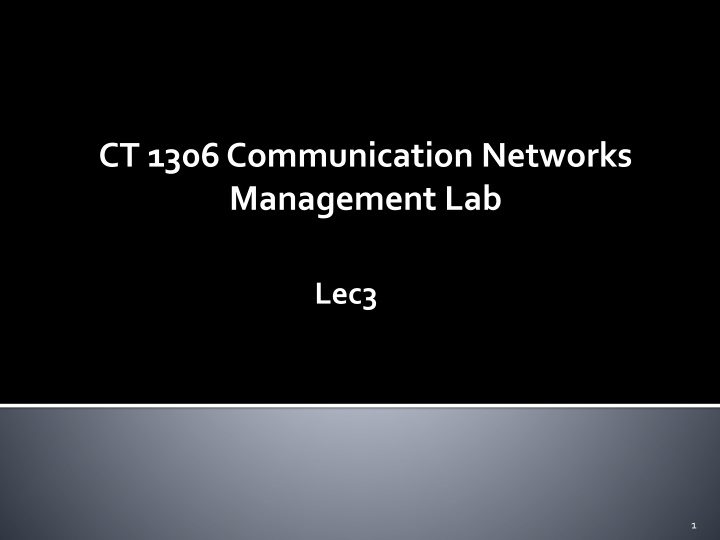
Troubleshooting Methods in Communication Networks Management
Discover troubleshooting methods in communication networks management, including using tools like ping, tracert, telnet, netstat, arp, and ipconfig. Learn how to test connectivity with the Ping utility, understand packet loss, and explore the benefits of tools like Tracert in network diagnostics.
Download Presentation

Please find below an Image/Link to download the presentation.
The content on the website is provided AS IS for your information and personal use only. It may not be sold, licensed, or shared on other websites without obtaining consent from the author. If you encounter any issues during the download, it is possible that the publisher has removed the file from their server.
You are allowed to download the files provided on this website for personal or commercial use, subject to the condition that they are used lawfully. All files are the property of their respective owners.
The content on the website is provided AS IS for your information and personal use only. It may not be sold, licensed, or shared on other websites without obtaining consent from the author.
E N D
Presentation Transcript
CT 1306 Communication Networks Management Lab Lec3 1
Troubleshooting methods include: Process of Elimination Divide and Conquer Software tools include: 3
Tool ping tracert telnet netstat arp ipconfig Use Main Options Verify basic connection Track packets by hops Layer 7 connectivity View protocol statistics -n sets the number of packets (default 5) -j specifies loose source route; -h max hops -s -p tcp shows TCP protocol statistics Map IP to MAC address View hosts IP settings -a show contents of cache; -s add static entry /all ; /renew requests a new DHCP lease
The PING utility tests connectivity between two hosts. PING uses a special protocol called theInternet Control Message Protocol (ICMP)to determine whether the remote machine (website, server, etc.) can receive the test packet and reply. Also a great way to verify whether you have TCP/IP installed and your Network Card is working. We'll start by Pinging the loopback address (127.0.0.1) to verify that TCP/IP is installed and configured correctly on the local computer. Type:PING 127.0.0.1 5
This tells me that TCP/IP is working as well as my Network Card. To test out connectivity to a website all you have to do is type:ping espn.com 6
The results should tell you if the connection was successful or if you had any lost packets. Packet loss describes a condition in which data packets appear to be transmitted correctly at one end of a connection, but never arrive at the other. Why? Well, there are a few possibilities. The network connection might be poor and packets get damaged in transit or the packet was dropped at a router because of internet congestion. Some Internet Web servers may be configured to disregard ping requests for security purposes. Note the IP address of espn.com -- 199.181.132.250. You can also ping this address and get the same result. However, Ping is not just used to test websites. It can also test connectivity to various servers: DNS, DHCP, your Print server, etc. As you get more into networking you'll realize just how handy the Ping utility can be. 7
Tracert is very similar to Ping, except that Tracert identifies pathways taken along each hop, rather than the time it takes for each packet to return (ping). 8
If I have trouble connecting to a remote host I will use Tracert to see where that connection fails. Any information sent from a source computer must travel through many computers / servers / routers (they're all the same thing, essentially) before it reaches a destination. It may not be your computer but something that is down along the way. It can also tell you if communication is slow because a link has gone down between you and the destination. If you know there are normally 4 routers but Tracert returns 8 responses, you know your packets are taking an indirect route due to a link being down. 9
The ARP utility helps diagnose problems associated with theAddress Resolution Protocol (ARP). TCP/IP hosts use ARP to determine the physical (MAC) address that corresponds with a specific IP address. Typearp with the a option to display IP addresses that have been resolved to MAC addresses recently. 10
Netstat (Network Statistics) displays network connections (both incoming and outgoing), routing tables, and a number of network interface statistics. It is an important part of theNetwork + exambut it's a helpful tool in finding problems and determining the amount of traffic on the network as a performance measurement. 12
Netstat s provides statistics about incoming and outgoing traffic 14
NSLookup provides a command-line utility for diagnosing DNS problems. In its most basic usage, NSLookup returns the IP address with the matching host name. 15
Not part of the TCP/IP utilities but it is useful to show current TCP/IP settings. The IPConfig command line utility will show detailed information about the network you are connected to. It also helps with reconfiguration of your IP address through release and renew. Let's say you want to know what you're IP address is --ipconfig is what you type in the command prompt. 16












